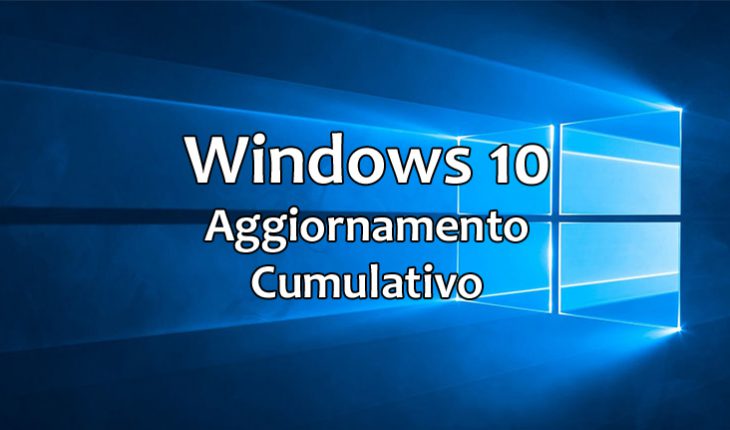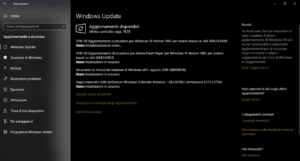L’aggiornamento cumulativo di Windows 10 del mese di agosto 2018 è in fase di rilascio. Sui PC e i tablet con Windows 10 v1803 (April 2018 Update) viene identificato con il codice KB4343909 e una volta installato porta il sistema alla Build 17134.228.
Sulle altre versioni di Windows 10 viene invece identificato come riportato di seguito:
- Fall Creators Update (v1709): KB4343897 – Build 16299.611
- Creators Update (v1703): KB4343885 – Build 15063.1266
- Anniversary Update (v1607): KB4343887 – Build 14393.2430
L’Aggiornamento Cumulativo di agosto è disponibile anche per gli smartphone con Windows 10 Mobile v1709 e una volta installato porta il sistema alla Build 15254.527 (vedi changelog a fine articolo).
Di seguito l’elenco delle correzioni e delle migliorie portate sui PC e sui Tablet con Windows 10 v1803:
- Provides protections against a new speculative execution side-channel vulnerability known as L1 Terminal Fault (L1TF) that affects Intel® Core® processors and Intel® Xeon® processors (CVE-2018-3620 and CVE-2018-3646). Make sure previous OS protections against Spectre Variant 2 and Meltdown vulnerabilities are enabled using the registry settings outlined in the Windows Client and Windows Server guidance KB articles. (These registry settings are enabled by default for Windows Client OS editions, but disabled by default for Windows Server OS editions.)
- Addresses an issue that causes high CPU usage that results in performance degradation on some systems with Family 15h and 16h AMD processors. This issue occurs after installing the June 2018 or July 2018 Windows updates from Microsoft and the AMD microcode updates that address Spectre Variant 2 (CVE-2017-5715 – Branch Target Injection).
- Addresses an issue that prevents apps from receiving mesh updates after resuming. This issue occurs for apps that use Spatial Mapping mesh data and participate in the Sleep or Resume cycle.
- Ensures that Internet Explorer and Microsoft Edge support the preload=”none” tag.
- Addresses an issue that prevents some applications running on HoloLens, such as Remote Assistance, from authenticating after upgrading from Windows 10, version 1607, to Windows 10, version 1803.
- Addresses an issue that significantly reduced battery life after upgrading to Windows 10, version 1803.
- Addresses an issue that causes Device Guard to block some ieframe.dll class IDs after installing the May 2018 Cumulative Update.
- Addresses a vulnerability related to the Export-Modulemember() function when used with a wildcard (*) and a dot-sourcing script. After installing this update, existing modules on devices that have Device Guard enabled will intentionally fail. The exception error is “This module uses the dot-source operator while exporting functions using wildcard characters, and this is disallowed when the system is under application verification enforcement.” For more information, see https://portal.msrc.microsoft.com/en-US/security-guidance/advisory/CVE-2018-8200 and https://aka.ms/PSModuleFunctionExport.
- Security updates to Windows Server.
Qui sotto le correzioni e le migliorie portate sugli smartphone con Windows 10 Mobile v1709:
- Provides protections against a new speculative execution side-channel vulnerability known as L1 Terminal Fault (L1TF) that affects Intel® Core® processors and Intel® Xeon® processors (CVE-2018-3620 and CVE-2018-3646). Make sure previous OS protections against Spectre Variant 2 and Meltdown vulnerabilities are enabled using the registry settings outlined in the Windows Client guidance KB article. (These registry settings are enabled by default for Windows Client OS editions.)
- Addresses an issue that causes Internet Explorer to stop working for certain websites.
- Updates support for the draft version of the Token Binding protocol v0.16.
- Addresses an issue that causes Device Guard to block some ieframe.dll class IDs after installing the May 2018 Cumulative Update.
- Ensures that Internet Explorer and Microsoft Edge support the preload=”none” tag.
- Addresses a vulnerability related to the Export-Modulemember() function when used with a wildcard (*) and a dot-sourcing script. After installing this update, existing modules on devices that have Device Guard enabled will intentionally fail. The exception error is “This module uses the dot-source operator while exporting functions using wildcard characters, and this is disallowed when the system is under application verification enforcement”. For more information, see https://portal.msrc.microsoft.com/en-US/security-guidance/advisory/CVE-2018-8200 and https://aka.ms/PSModuleFunctionExport.
- Addresses an issue that was introduced in the July 2018 .NET Framework update. Applications that rely on COM components were failing to load or run correctly because of “access denied,” “class not registered,” or “internal failure occurred for unknown reasons” errors.
- Security updates to Windows Server.
Se il vostro PC non ha già fatto da sé, potete scaricare ed installare questo update manualmente accedendo a Impostazioni, Aggiornamento e Sicurezza, e cliccando o toccando la voce “Verifica disponibilità aggiornamenti”. In alternativa potete scaricare l’installer da questa pagina web e procedere all’installazione manuale.
Ricordiamo che se desiderate confrontarvi con altri utenti su un differente argomento, il luogo migliore per farlo è questa sezione dedicata del nostro Nokioteca Forum.



Fiondatevi a controllare gli aggiornamenti del telefono!?
2018-08 Aggiornamento per Windows 10 Version 1709 per dispositivi Phone basati su arm
W10M FCU 15254.527
W10M CU 15063.1266
W10M AU 14393.2431
@yepp L’ultima mi interessa
In cosa può consistere ?
@yepp ho appena finito di installare l’aggiornamento del mio lumia 532
Novità su mobile?
Le novità visibili sono:
– Sono state abilitate di default altre protezioni contro le vulnerabilità di Spectre e Meldown
– Sono stati corretti alcuni errori nel motore di Internet Explorer/Edge che causavano un improvviso blocco su certi siti
– E’ stato introdotto il supporto al protocollo di Token Binding protocol v0.16 per le sessioni TLS
– E’ stato introdotto il supporto al tag preload=”none” in Microsoft Edge
Il mio 920 non si aggiorna. Come mai???
@FedePablo Come scritto nell’articolo, l’aggiornamento per gli smartphone è disponibile se si ha Windows 10 Mobile v1709… Dubito fortemente che il tuo Lumia 920 abbia tale versione…
@FedePablo Buttalo nel secchio ?
Per chi è su AU c’è la nuova build 14393.2431
???
Io ho impostato la luce notturna di Windows dalle 19:00 alle 07:00 e in questi giorni di ferie mi sono accorto che se accendo il pc prima delle 07 la luce notturna si spegne regolarmente allo scoccare di quest’ora, mentre se l’accendo dopo le 07 spesso rimane accesa. Nel “what’s new” elencato nell’articolo non c’è scritto ma spero risolva questo bug. ?
Mi rispondo da solo, no, non è stato risolto. Il bug persiste ancora. Credo che dopo le 19 quando entra in funzione automaticamente, se disattivi la luce esempio per guardare un film la sera e poi la riattivi, il giorno dopo fa questo scherzo se il pc viene acceso dopo le 07. A questo punto mi sa tanto che accantono questa funzione nativa di Windows e tornerò con f.lux che tra l’altro ora è anche nello store. Almeno mi eviterò la noia di fare tutto a mano e quando guarderò un film a schermo intero, si disattiverà automaticamente. ?
Cos’è il Token Binding protocol?
É un meccanismo di sicurezza in più che si può usare per rendere ancora più sicure le connessioni https TLS
@yepp a perfetto grazie =)
Aggiornato senza problemi lumia 650….quando meno te lo aspetti, aggiornano ancora WM10 mobile…?
App il meteo..non fun.piu
Rimuovi la tile e riaggiungila
Fatto. Ma non funz. Piu
Stranissimo. Vai sullo Store e vedi se ti sgancia una versione aggiornata di quell’app.
A me tutto ok. Forza Windows….